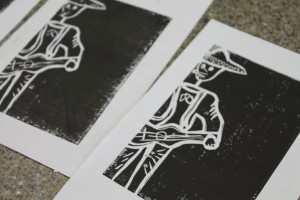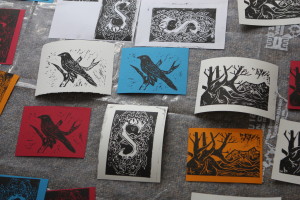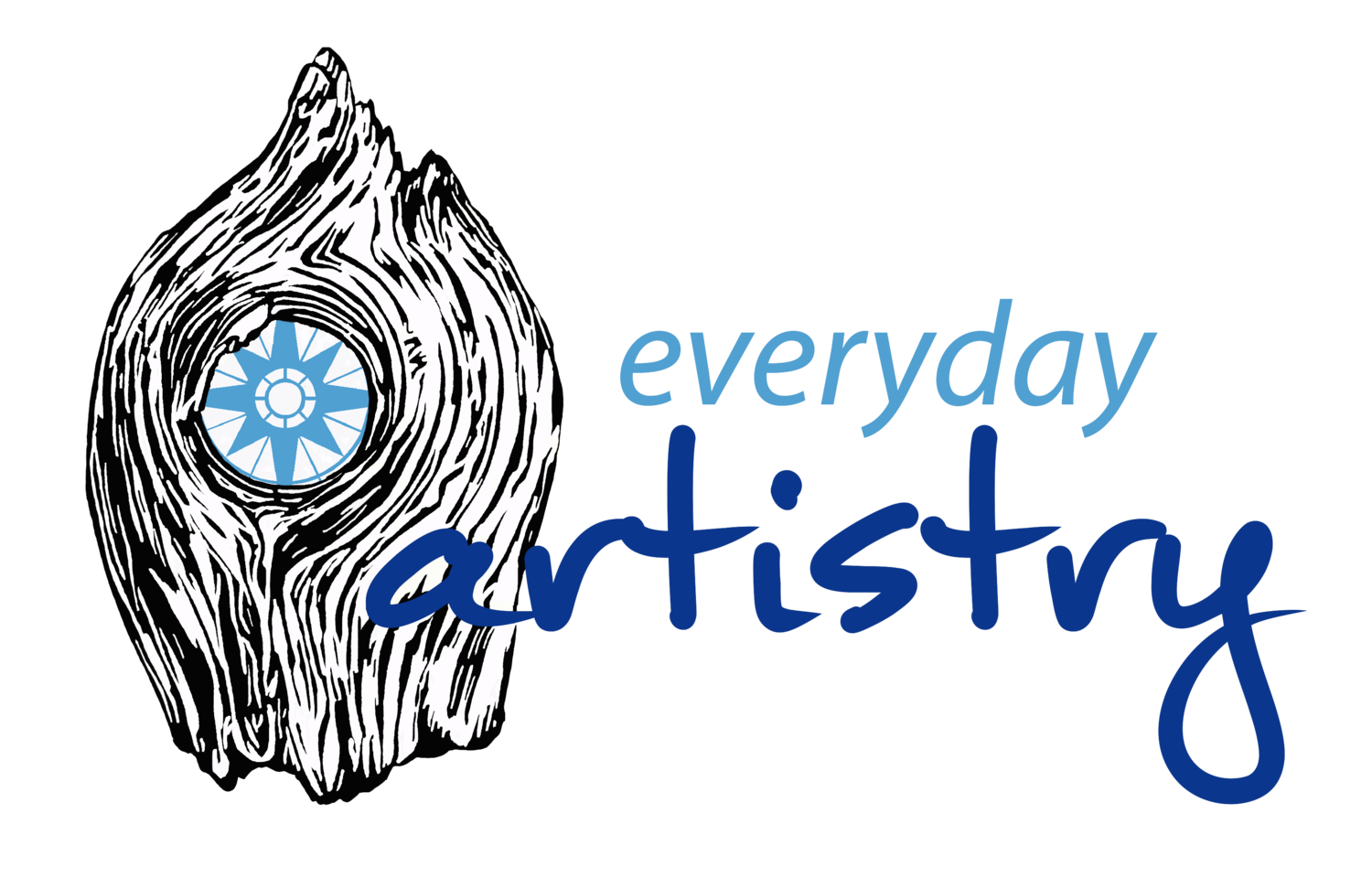Field notes are the name that I give to any sketches drawn or notes written "in the field"—the field being anywhere that isn't at home or at work. They imply notetaking in the moment and the recording of observations. I tend to take a lot of field notes while traveling but I've been wanting to get into the habit in my regular life as well. I'm always coming home from walks with stories of the 'amazing' (at least to me) birds or flowers that I saw and I wanted to start intentionally recording these moments.
New printmaking workshop at Habitat Etc.
A magical night at Nuit Blanche
A couple weekends ago, Edmonton saw its first Nuit Blanche event take over downtown and transform it into one giant art party. There was a pedway full of balloons (well, half full), a stack of bouncy castles, 120 trees covered in wishes, decorated potholes and dozens of other creations. I didn't get to see any of that. I was in my booth at the Grand Market from 7pm until 3am, selling my artwork and watching something amazing unfold.
Maps as Inspiration and the Stories They Tell
 If you've followed me from my I Heart Edmonton days, or have seen very much of my artwork, you'll know that I'm a teensy bit obsessed with maps. I'm inspired by them and love incorporating them in my work. What's the big deal about maps? I could write for days about all the interesting things I've learned about them (and maybe someday I will), but for now I'll just share what I think is one of their most interesting features: how we can use them to tell stories.
If you've ever taken a road trip, you can identify with the map as storyteller. It shows you the ground you've covered since leaving home. A few years ago my brother and I drove all the way around the United States, touching 34 states in 2 months, and I used a map to keep track of our route. I kept it as a souvenir: the thick yellow line running in a rugged circle around the country reminds us of where we went, of the things we saw, and of the adventures we had. That yellow line is as evocative for me as a photo album.
If you've followed me from my I Heart Edmonton days, or have seen very much of my artwork, you'll know that I'm a teensy bit obsessed with maps. I'm inspired by them and love incorporating them in my work. What's the big deal about maps? I could write for days about all the interesting things I've learned about them (and maybe someday I will), but for now I'll just share what I think is one of their most interesting features: how we can use them to tell stories.
If you've ever taken a road trip, you can identify with the map as storyteller. It shows you the ground you've covered since leaving home. A few years ago my brother and I drove all the way around the United States, touching 34 states in 2 months, and I used a map to keep track of our route. I kept it as a souvenir: the thick yellow line running in a rugged circle around the country reminds us of where we went, of the things we saw, and of the adventures we had. That yellow line is as evocative for me as a photo album.
Maps can also tell the stories of where we want to go. I'm thinking of all the times I've planned a trip - whether to a foreign continent, or to an unfamiliar part of of the city I live in - poring over the details on a map, trying to visualize a journey from one place to another and imagining how it might turn out.
Even if we spend most of our lives in one place and have no need to physically look at a map, they are still constantly helping us understand the world around us. We create mental maps of places familiar to us: of our route to work, of the aisles we regularly visit in the grocery store, of our path around the house as we get ready in the morning. Just think of how disorienting it is to walk into a grocery store in a different part of the city; on the outside it looks the same as the one we're used to, but inside things are backwards or mixed up. Our mental map tells us to go one way but reality tells us something different. These mental maps help us define how we fit into the world around us.
Mapping can be more abstract as well. We talk about mapping out our future, or making mind maps when we're trying to solve a problem. Though they refer to time or ideas rather than space, these visual representations have as much to say to us as the maps created by our footsteps. To create a map of the future, we have to explore the map of the past, examining what worked and what didn't and using that as a jumping off point to get somewhere new. When we explore the contents of our mind, we are sometimes surprised to discover uncharted territory. Either way we learn something new about our character and our stories.
Our bodies, too, form maps as we seek to understand and cure injuries or illnesses. I recently spent 5 months seeing a physiotherapist for pain in the back of my leg. The pain moved around, traveling up and down and the physiotherapist had to explore the interactions between different parts of my body to discover the cause and to heal it. I can now trace the path between tension in my lower back and pain behind my knee. I have a map. And I have a story.
We normally associate maps with straightforward geography, looking at them as completely objective representations. But they can mean so much more if you're willing to dive in and explore a bit. I would be willing to bet that no two people would draw a map of an area in exactly the same way; everyone sees things a little differently, and everyone's interpretations would vary. Some might focus more on physical details, and some on emotional. Think about it: if you were to draw a map that told the story of you, what would it look like?
If all this talk of maps and stories has got you excited and you want to explore the topic further, I will be teaching a brand new workshop on Wednesday, October 1, 2014 from 6-8pm called Personal Map-Making in which I will guide you through the process of mapping your own story. Will you choose to focus on geography or on emotional states? On networks of relationships or of memories? Either way, everyone has a powerful tale to tell, and I hope that you'll join me to try to represent that tale with your own unique map. Find more information and register here.
4 Things You'll Learn in My Printmaking Workshop
What I love most about teaching this workshop is that it's not just about making linoleum block prints. That's a huge part of it, obviously, but there are a few other things that I think it's important to teach, and they're things you might not have thought of. Here are four of them:
1. How to take an idea from start to finish
Tell me if this sounds familiar: you have the best idea for a project, or something new you want to try. You go out and get all the supplies and dive in, full of enthusiasm, only to give it up halfway through without finishing. We all do this. When something gets hard, frustrating, or even just a little less exciting, we tend to give up and move on to other things. I used to do it all the time. In this workshop, however, you'll get the satisfaction of starting something, and then finishing it. You will leave knowing exactly how to overcome those frustrating challenges that might have made you give up if you were doing it on your own. And hopefully that sense of satisfaction you get from completing a project will motivate you to try and finish more.
2. How to be patient with yourself
When learning a new skill, it's easy to get fed up and decide, "I'm just not good at this. I shouldn't even bother." We've all heard about the value of having patience with ourselves, but how often do we actually practice it? In this workshop I'll provide that gentle voice that tells you to keep going, to keep trying, that it's not as bad as you think it is. I'll help you focus on what's going well and remind you to cut yourself some slack. Once you see that patience pay off, you'll be more likely to practice it in the future.
3. How to handle "mistakes"
With this art form it's inevitable that you will make a mistake - probably a few mistakes actually. I still slip when I'm carving the linoleum and create scratches and lines that I don't want. The only way to deal with this is to try to make it part of the design, to make it look like you meant to do it. This requires a little bit of creative problem solving and I'll be there to help you make sure that your "mistakes" end up looking beautiful.
4. That you're more creative than you think you are
Many people think that if they don't draw their design themselves that they're not being creative. They're usually surprised, then, by how unique and beautiful their prints turn out. The truth is that just by choosing something to turn into a print, you're making a creative decision. You make more creative decisions when you decide how you'll carve it, what parts you'll leave white and what parts will be black, and then how you'll print it, with more or less ink. If you've never done anything "artistic" before, and think you're just not cut out for it, I'll show you how simple it can be to make a work of art that others will marvel at. Don't believe me? All the prints featured in this post were created by past students, many of whom don't consider themselves to be particularly artistic. My favourite part of the workshop is watching students pulling the paper off and seeing their prints for the first time. The amazement and wonder on their faces makes my day.
 I hope you'll join me at the next workshop on Saturday, September 27th from 1-5. There are only 5 spots available, so sign up now!
I hope you'll join me at the next workshop on Saturday, September 27th from 1-5. There are only 5 spots available, so sign up now!
More information and registration here.




